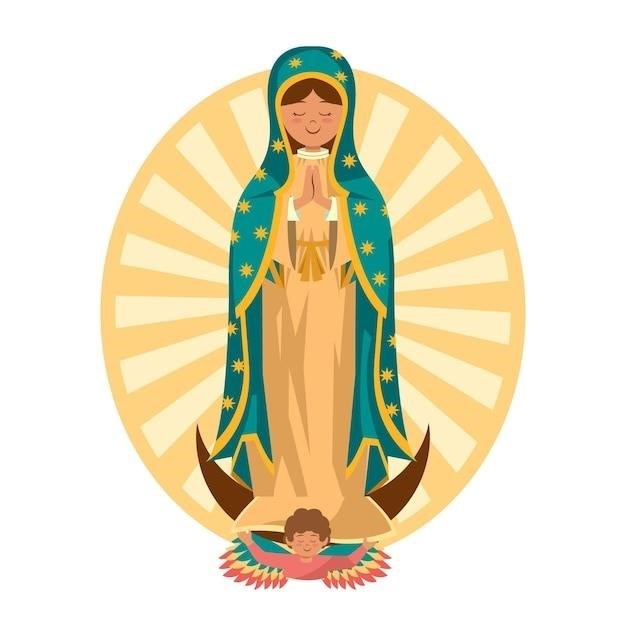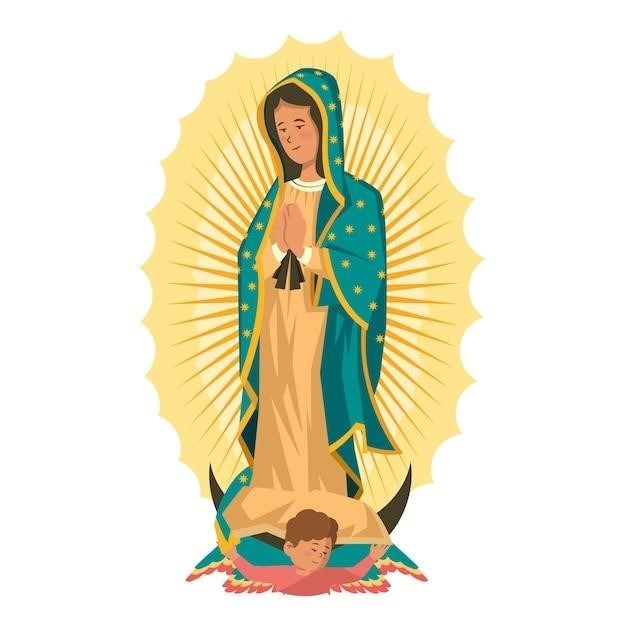
The Complete Guadalupan Rosary⁚ A Comprehensive Guide
This guide offers a thorough exploration of the Guadalupan Rosary, detailing its history, structure, and significance within Catholic tradition. Discover the seven mysteries reflecting Our Lady of Guadalupe’s apparitions to Juan Diego, and learn how to pray this powerful rosary. Downloadable PDFs and additional resources are included for enhanced devotion.
The Guadalupan Rosary holds profound spiritual significance for millions of Catholics worldwide, particularly in Mexico and throughout Latin America. It’s a deeply devotional practice centered on the apparitions of the Virgin Mary to Juan Diego in 1531. Unlike the traditional rosary, this version focuses on the seven key events surrounding these miraculous appearances. Each mystery provides a powerful meditation on faith, hope, and divine intervention. Reciting the Guadalupan Rosary is seen as a way to connect directly with the Virgin of Guadalupe, seeking her intercession and blessings. The devotion emphasizes the miraculous image on Juan Diego’s tilma and its enduring message of love, hope, and salvation. This unique rosary allows for deeper reflection on the specific details and profound spiritual significance of the Guadalupan apparitions, enriching one’s faith and fostering a closer relationship with Mary.
The History and Origins of the Guadalupan Rosary
The Guadalupan Rosary’s precise origins aren’t definitively documented in a single historical source. However, its development is intrinsically linked to the enduring devotion surrounding Our Lady of Guadalupe and her apparitions to Juan Diego. The rosary’s structure likely evolved organically from the existing tradition of the traditional rosary, adapting it to specifically contemplate the events of the Guadalupe apparitions. Given the immense popularity of the Marian devotion in Mexico and beyond, various versions and adaptations of the Guadalupan Rosary have likely emerged over time, reflecting local customs and preferences. While a single, universally accepted “first” version may not exist, the common thread remains a focus on meditating on the seven key events of the apparitions, deepening the spiritual experience for those who pray it. The lack of a definitive origin story doesn’t diminish its profound impact on Catholic devotion.
The Structure of the Guadalupan Rosary⁚ Key Differences from the Traditional Rosary
While sharing the fundamental structure of a rosary—using decades of Hail Marys and Our Fathers—the Guadalupan Rosary distinguishes itself through its unique focus. Instead of the traditional Joyful, Sorrowful, Glorious, and Luminous Mysteries, it centers on seven key events from the apparitions of Our Lady of Guadalupe to Saint Juan Diego. Each of these seven mysteries replaces a traditional decade, offering a distinct meditative journey. The prayers within each decade might also vary, incorporating specific invocations or reflections pertinent to Guadalupe’s apparitions. Some versions might maintain the standard opening and closing prayers, while others might include additional prayers specific to Our Lady of Guadalupe. The core difference lies in the thematic content of the meditations, shifting the focus from the life of Christ (as in traditional rosaries) to the events surrounding the apparition and their theological significance. This substitution creates a unique contemplative experience.

The Seven Mysteries of the Guadalupan Rosary⁚ Detailed Explanation
The Guadalupan Rosary unfolds through seven mysteries, each reflecting a pivotal moment in the apparitions of Our Lady of Guadalupe. These mysteries offer a profound meditation on the divine intervention and the transformative power of faith. Unlike the traditional rosary’s cyclical mysteries, the Guadalupan version presents a linear narrative, following the chronological sequence of events. Each mystery provides a unique opportunity for contemplation, fostering a deeper connection with the Guadalupan tradition. The specific details within each mystery may vary slightly depending on the source, but the core events remain consistent. This structured approach allows for a focused meditation on the significance of each event in the context of the overall narrative of the apparitions, enriching the spiritual experience. The mysteries typically include the initial apparition, the request for a sign, the miraculous image on the tilma, its presentation to the bishop, and the healing of Juan Diego’s uncle. The complete set of seven often incorporates additional significant events from this pivotal period in Mexican history.
Mystery 1⁚ The First Apparition to Juan Diego
This pivotal mystery recounts the initial encounter between Juan Diego, a humble indigenous peasant, and the Virgin Mary on Tepeyac Hill in 1531. The apparition, radiant and beautiful, revealed herself as the “Mother of the True God.” This first encounter sets the stage for the unfolding events, establishing the miraculous nature of the appearances and the humble instrument chosen to convey the divine message. Meditating on this mystery invites reflection on the importance of humility and openness to divine revelation, even amidst the ordinary circumstances of daily life. The scene is often depicted in religious art, showcasing the Virgin’s gentle presence and Juan Diego’s awe-struck reaction. The mystery emphasizes the Virgin’s compassion and her desire to communicate directly with the indigenous people of Mexico, establishing a significant moment in the fusion of indigenous and Catholic faith. The profound grace of this first encounter serves as a foundation for understanding the subsequent mysteries and the overall significance of the Guadalupan apparitions.
Mystery 2⁚ The Request for a Sign
Following the first apparition, Juan Diego, understandably hesitant to believe the extraordinary claim, requested a sign from the Virgin Mary to prove the authenticity of her message. This request highlights the human element within the divine narrative. It emphasizes the importance of faith, yet acknowledges the natural human need for tangible evidence. The Virgin’s response to Juan Diego’s request, while not immediately granted, foreshadows the miraculous events to come. This moment of doubt and subsequent request for a sign allows for a deeper reflection on the nature of faith and the process of belief. It also highlights the importance of perseverance in seeking spiritual truth. The Virgin’s patience and understanding in her response further underscore her compassionate nature and the divine plan unfolding. This mystery underscores the ongoing dialogue between the divine and the human, emphasizing the role of humility and trust in the face of the extraordinary.
Mystery 3⁚ The Miraculous Image on the Tilma
This pivotal mystery recounts the miraculous appearance of the Virgin Mary’s image on Juan Diego’s tilma. Following the Virgin’s instruction, Juan Diego gathered roses on the barren Tepeyac Hill, a clear sign of divine intervention. Upon opening his tilma before Bishop Zumarraga, the image of Our Lady of Guadalupe was revealed, flawlessly imprinted on the humble fabric. This miraculous image, enduring centuries despite expected deterioration, stands as a powerful testament to the Virgin’s presence and the divine message she conveyed. The intricate detail and lifelike quality of the image continue to astound and inspire awe. This event serves as the cornerstone of Guadalupan devotion, solidifying the authenticity of the apparitions and establishing a lasting symbol of faith. The image’s enduring beauty and the scientific mysteries surrounding its preservation further enhance its miraculous nature and continue to draw millions to its profound message of hope and divine love.
Mystery 4⁚ The Presentation of the Tilma to the Bishop
This mystery focuses on the dramatic moment when Juan Diego, emboldened by the Virgin’s unwavering support, presents the miraculous image on his tilma to the skeptical Bishop Zumarraga. Initially doubtful, the Bishop had requested a sign from the Virgin Mary as proof of Juan Diego’s claims. The unveiling of the image, a stunning depiction of the Virgin Mary, immediately silenced any doubt. The vibrant colors, lifelike features, and the sheer improbability of the image’s creation on such a simple garment astonished the Bishop. This event marked a turning point, transforming skepticism into profound belief and solidifying the authenticity of the apparitions. The Bishop’s conversion and subsequent acceptance of the miraculous image serve as a powerful testament to the divine intervention at play. This profound moment underscores the power of faith and the unwavering devotion of Juan Diego, whose humble obedience led to a pivotal moment in Catholic history and the birth of a significant Marian devotion.
Mystery 5⁚ The Healing of Juan Diego’s Uncle
This pivotal mystery highlights the compassionate nature of the Virgin Mary and the miraculous power associated with her apparitions. Juan Diego’s uncle, seriously ill, was near death. Desperate for a cure, Juan Diego turned to the Virgin Mary for help. She instructed him to gather flowers from the barren Tepeyac Hill, a seemingly impossible task. Upon gathering the miraculously blooming Castilian roses, Juan Diego presented them to the Virgin, who then instructed him to use the flowers to cover his ailing uncle. Upon opening his tilma to reveal the radiant flowers, Juan Diego’s uncle was instantly healed! This miracle serves as a potent symbol of the Virgin’s healing power and her boundless compassion for those who seek her intercession. The miraculous healing strengthened Juan Diego’s faith and provided further evidence of the divine nature of the apparitions, solidifying the growing devotion to the Virgin of Guadalupe. The event also illustrates the Virgin’s role as a healer and intercessor, demonstrating her concern for both physical and spiritual well-being.
Prayers and Invocations within the Guadalupan Rosary
The Guadalupan Rosary incorporates traditional prayers like the Our Father, Hail Mary, and Glory Be, but also integrates unique invocations specific to the Guadalupan apparitions. These additions enrich the meditative experience, focusing on the events surrounding the miraculous image and Juan Diego’s encounters with the Virgin Mary. Expect to find prayers of supplication, expressing gratitude for the Virgin’s intercession, and requests for her continued protection and guidance. Some versions might include specific litanies to Our Lady of Guadalupe, enhancing the devotional aspect. These unique prayers often emphasize themes of faith, hope, healing, and national identity, reflecting the profound impact of the Guadalupan apparitions on Mexican culture and spirituality. The inclusion of these specific prayers and invocations helps to deepen the connection between the practitioner and the Virgin, creating a more immersive and meaningful prayer experience tailored to the Guadalupan tradition. The precise wording may vary between different versions of the rosary, but the overall spirit remains consistent.
Finding and Downloading Guadalupan Rosary PDFs
Numerous online resources offer downloadable PDFs of the Guadalupan Rosary. A simple web search for “Guadalupan Rosary PDF” will yield various results, including those from Catholic websites, diocesan pages, and devotional sites. Be discerning in your selection, prioritizing reputable sources to ensure accuracy and theological soundness. Some PDFs may include additional prayers, reflections, or historical context alongside the rosary itself. Others might focus solely on the prayer sequence, offering a concise and straightforward guide. Consider the format and content that best suits your needs. You might find versions in Spanish and English, catering to diverse linguistic preferences. Remember to check the copyright information before distributing or reproducing any downloaded material. Always verify the source’s credibility to ensure the integrity and authenticity of the Guadalupan Rosary text presented within the PDF.
Resources for Guadalupan Rosary Devotion
Beyond downloadable PDFs, a wealth of resources enhances Guadalupan Rosary devotion. Websites dedicated to Our Lady of Guadalupe offer insightful articles, historical accounts, and theological reflections enriching your understanding and appreciation. Many Catholic parishes and dioceses provide materials, including booklets and prayer cards, further supporting your prayer life. Consider exploring online forums and communities dedicated to Marian devotion, where you can connect with fellow practitioners, share experiences, and learn from others’ insights. You might find audio recordings of the rosary, guided meditations, or even videos explaining the mysteries in greater detail. Books focusing on the apparitions of Guadalupe and their significance within the Catholic faith provide a deeper understanding of the devotion’s context. These resources not only help with the prayer itself but also deepen your connection to the historical and spiritual aspects of the Guadalupan tradition. Remember to seek out diverse perspectives to enrich your faith journey.
Conclusion⁚ Embracing the Guadalupan Tradition
The Guadalupan Rosary offers a profound path to connect with the powerful spiritual legacy of Our Lady of Guadalupe. Through its unique mysteries, it invites a deeper reflection on the apparitions and their enduring impact on faith. This rosary, easily accessible through various online and offline resources, provides a tangible way to engage with this important Catholic devotion. By incorporating the Guadalupan Rosary into your prayer life, you embrace not just a specific form of prayer, but also a rich history and a vibrant tradition. The accessibility of PDFs and other materials makes this powerful devotion available to everyone. More than a mere recitation, the Guadalupan Rosary offers an opportunity for personal growth, spiritual reflection, and a strengthening of one’s faith. It’s a journey of connection, a testament to the enduring power of Marian devotion, and a means to draw closer to the divine through the intercession of Our Lady of Guadalupe.
